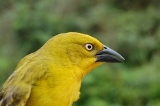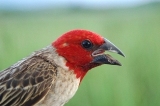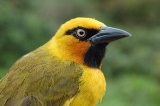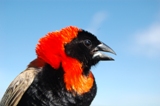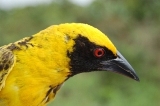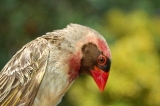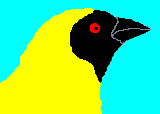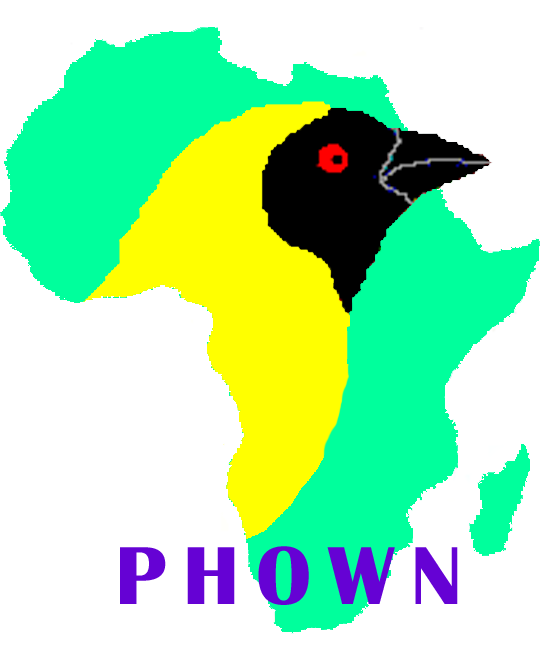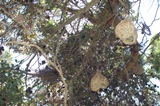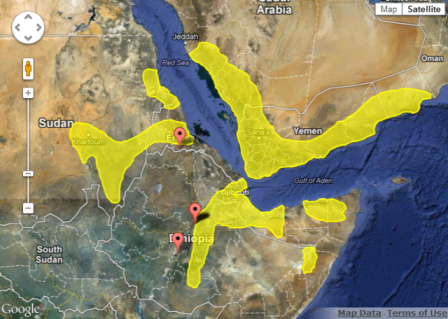Weaver species
Choose different species from drop-down list and press 'Go' button. See Full species list.Ruppell's Weaver Ploceus galbula
IUCN: Least concern Discovery: 043Categories: acacias, gum, nectar, pest,
News items about species
Discovery
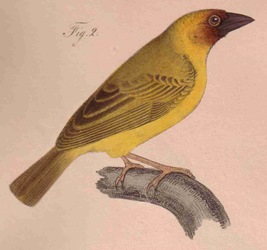
figure from Ruppell 1840 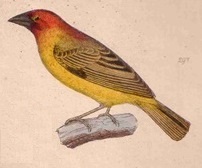
different races figure from Reichenbach 1863 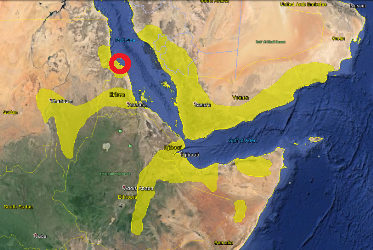
distribution, type locality circled IntroductionThe Rüppell's Weaver was formally described by Wilhelm Peter Eduard Simon Rüppell, a German naturalist and explorer, especially in north-east Africa. Rüppell was the first naturalist to travel through Ethiopia and many birds are named after him.Rüppell thought this species was an oriole, hence the latin name he chose (see below). He described a male, female and young bird, finding Rüppell's Weaver to be a common species in the Modat valley on the coast of Eritrea, where he collected the specimens. On Rüppell's third journey to Africa, in 1831-34, he travelled to the Sinai Peninsula, Egypt, and along the coast of the Red Sea to Massawa (Steinheimer 2005). It is unclear where the Modat valley lies, and the area of Massawa on the coast is considered the modern type locality for the Rüppell's Weaver. Rüppell stayed in this area a few months at the end of 1831 and into early 1832. The first illustration of a Rüppell's Weaver is a colour painting in Ruppell 1840. The next illustration is by Reichenbach (1863), also of an adult male. Scientific citationPloceus galbula Ruppell 1840 Neue Wirbelt., Vogel, p.92, pl. 32 (fig. 2); Modat Valley, Eritrea.Meaning of namesgalbula - Latin: a small yellowish bird (dim. of galbina, a small yellow bird; galbus, yellow).First English nameThe Oriole Weawer (Reichenbach 1863).Alternate namesCanary Weaver, The Oriole Weawer.CollectorEduard Rüppell.Date collected1831 or 1832.Locality collectedModat Valley [=Massaua area], Eritrea.Type specimensOne specimen is known to be in the Senckenberg Museum in Frankfurt (specimen 12644), but more types should still exist. |
The above is based on Weaver Wednesday 2, a weekly series about the discovery of each weaver species.
This species text first appeared as
Weaver Wednesday [160] - Discovery [43]: Rüppell's Weaver on 2015-07-08
1. Basic biology
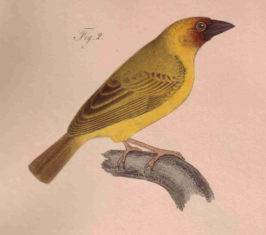
Identification. The adult male Rüppell's Weaver is yellow with a red eye and a chestnut mask which may appear black from a distance. Females and non-breeding males are dull coloured. Distribution. Rüppell's Weaver is the only weaver found naturally in the Middle East. A few subspecies have been described for Rüppell's Weaver in the past, but are no longer considered valid. This species was first described and illustrated (painting left) by Eduard Rüppell, who also described the Lesser Masked, Chestnut and White-headed Buffalo Weavers from North-East Africa. The distribution map (below) of Rüppell's Weaver is based on Handbook of the Birds of the World, Vol. 15, showing the current PHOWN records. It has been recorded in NE and E Sudan, N Eritrea (including Dahlak Archipelago in the Red Sea), C and NE Ethiopia, Djibouti, N Somalia, and S Arabian Peninsula (SW Saudi Arabia, Yemen, W Oman).
There is an introduced population of Rüppell's Weaver in Kuwait. Habitat. Rüppell's Weaver is found in savanna, arid coastal plains, cultivated areas, wetlands and gardens. Food. Rüppell's Weaver feeds on seeds, including cereal crops. It may flock in thousands and cause crop damage, while in Arabia flocks are smaller. Breeding. Rüppell's Weaver often nests in colonies of several males, but single-male colonies may occur. In Yemen colony size varies from 4 to 50 nests. Nest sites include a variety of tree species, often thorny species, and often built over water. Males are polygnous and will breed with up to three females, and typically build up to eight globular nests. The nests are woven from grass or long strips of palm fronds. lnitially the nest lacks an entrance tunnel, but a tunnel of 50 mm may be added later.
Two or three eggs are laid and these vary in colour - either white or blue, usually heavily spotted, sometimes only finely speckled, with brick-red. Incubation is by the female. Usually in polygnous weavers the female does most of the work of feeding chicks. In Rüppell's Weaver the male feeds the young chicks by regurgitation while the female broods them. After four days, both sexes feed the chicks. |
The above is based on Weaver Wednesday, a weekly series about weaver species.
This species text first appeared as
Weaver Wednesday [17]: Rüppell's Weaver on 2012-10-10
2. Breeding facts
| Pair bond Polygynous, sometimes single male with up to three females and eight nests Breeding season Sudan, season May-Aug in Gedaref area, Mar-May elsewhere; breeds in all months except Jun-Aug in Eritrea, all months except Mar-Apr in Ethiopia; Feb-Mar, May-Jun and Nov in Somalia; in Yemen mainly Mar-Aug, but in any month when rain falls (one observer noted breeding in Feb, Apr, Jun-Jul, Oct and Dec); Dec-Mar in Saudi Arabia and Mar-Sept in Oman Nest site supended 2-6 m above ground, where possible over water, from end of branch in tree, bush or mature durra Sorghum bicolor) stalks, sometimes eucalypt (Eucalytus), date palm (Phoenix dactylifera) or tamarind trees (Tamarindus), in Arabia also Ziziphus spina Nest building woven by male Colony size sometimes single male with up to three females and eight nests. Often colonial nester Clutch size 2-3 eggs Egg colour white or deep blue, usually heavily spotted with brick-red, sometimes only finely speckled Egg size average size of 17 eggs 20 x 13.8 mm (Somalia) Incubation incubation by female, period 14-15 days Chicks and nestling period chicks brooded by female, initially food brought by male, which feeds chicks by regurgitation, after day 4 both sexes feed, nestling period c. 18 days |
Breeding information based on Handbook of the Birds of the World, Vol. 15.
3. Photos of Weaver Nests
 Vm 30858 |  Vm 30857 |  Vm 29338 |  Vm 29337 |  Vm 29336 | 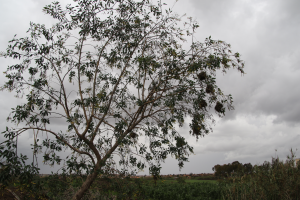 Vm 27671 |
Thumb-nails of most recent PHOWN records - click on one to see its full record
See all PHOWN records for this species here.
PHOWN (Photos of Weaver Nests) provides valuable info on breeding distribution and colony sizes of weavers.
You can contribute by registering and submitting photos at Virtual Museum webpage.
4. Breeding distribution
Google map showing distribution (For species with small ranges you need to zoom in at the correct area to see the range):
yellow blob - range of weaver species; read more about this here.
![]() - PHOWN records with photos
- PHOWN records with photos
![]() - PHOWN records with no photos (Nest Record Cards, other records)
- PHOWN records with no photos (Nest Record Cards, other records)
![]() - Birdpix records
- Birdpix records
![]() - comments on out of range records, or interesting records
- comments on out of range records, or interesting records
![]() - type locality
- type locality
CLICK on the marker on the map to see individual record details.
5. Range changes
Not South African speciesThe above is based on Weaver Wednesday 3, a weekly series about range changes in South African weaver species.
This species text first appeared as
n/a
